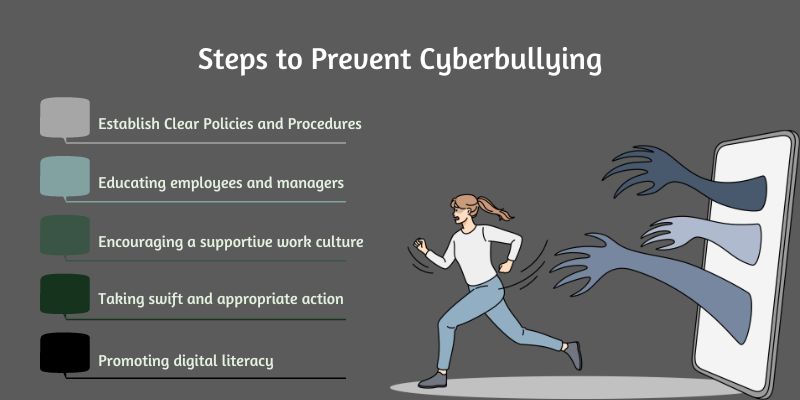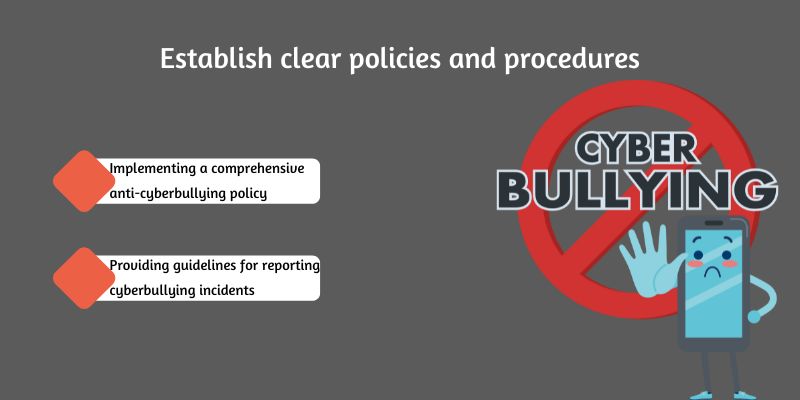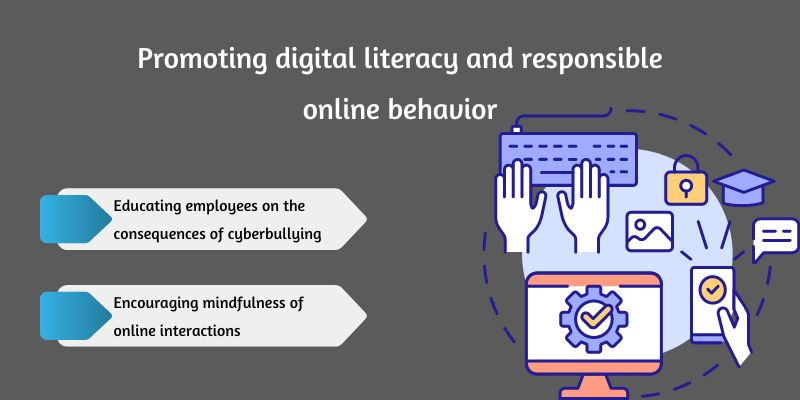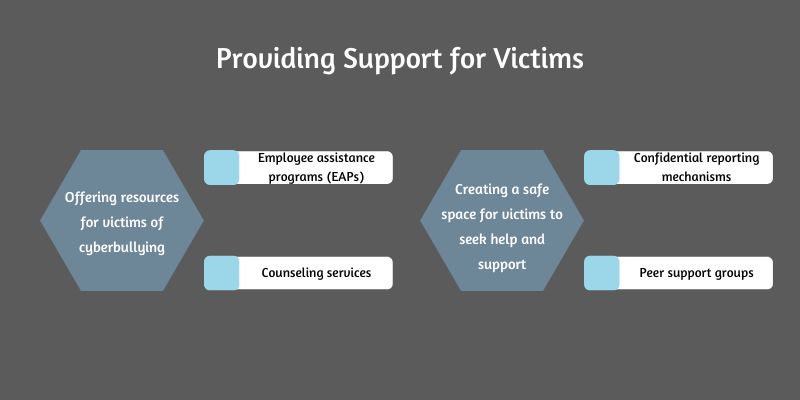In today's digital age, cyberbullying has become a significant concern in the workplace. Understanding what it is, how common it is, and why it's crucial to address it is essential.
Forty percent of Canadian workers experience bullying every week. Moreover, 7% of adult internet users in Canada reported experiencing cyberbullying at some point in their lives. The most common form of cyberbullying involves receiving threatening or aggressive emails or instant messages.
But what is cyberbullying?
It uses digital communication tools such as email, social media, or messaging apps to harass, intimidate, or humiliate others.
Cyberbullying in the workplace is more common than many people realize. It can take various forms, including spreading rumors, derogatory comments, or sending threatening or offensive messages.
Addressing cyberbullying is crucial because it can have severe consequences for both employees and the organization as a whole. It can lead to decreased productivity, low morale, and even legal issues.
Creating a safe and respectful work environment is essential for the well-being and success of all employees.
In this article, we will explore practical strategies and techniques for dealing with cyberbullying in the workplace.
Individuals and organizations can create a safer, more supportive, and productive work environment by understanding how to identify, prevent, and respond to cyberbullying. So, let’s start!
5 Steps to Preventing Cyberbullying
Cyberbullying can have severe consequences in the workplace. To prevent workplace harassment, especially cyberbullying, organizations must take proactive steps. Here are essential strategies:

1. Establish Clear Policies and Procedures

Institute comprehensive policies and procedures explicitly addressing cyberbullying.
Implementing a Comprehensive Anti-Cyberbullying Policy
Develop and implement a comprehensive anti-cyberbullying policy that defines cyberbullying, outlines unacceptable behavior, and establishes consequences.
The policy should be communicated to all employees, ensuring they understand what constitutes cyberbullying and the repercussions for engaging in such behavior.
Providing Guidelines for Reporting Cyberbullying Incidents
Establish clear guidelines for reporting cyberbullying incidents. Employees should know how and to whom they can report bully at work.
Ensure confidentiality and provide various reporting options, such as direct reporting to HR, anonymous reporting, or using a third-party reporting system.
Support victims, including counseling services, legal assistance, or other necessary resources.
2. Educating Employees and Managers
Educating employees and managers on cyberbullying is crucial for prevention.
Training Sessions on Recognizing and Preventing Cyberbullying
Organize regular sessions of Workplace Violence and Harassment Awareness Training to educate employees and managers on recognizing and preventing cyberbullying.
Train them to identify the type of workplace harassment cyberbullying behavior, understand its impact, and intervene appropriately. Offer guidance on using digital platforms responsibly and professionally.
Promoting Digital Etiquette and Respectful Communication
Promote digital etiquette and respectful communication among employees. Encourage transparent and respectful online interactions and discourage behaviors that could be perceived as cyberbullying.
Emphasize the importance of treating colleagues respectfully, whether in person or online.
A clear policy and reporting procedures ensure that cyberbullying incidents are promptly addressed and employees feel safe and supported.
Creating a culture of respect and zero tolerance for cyberbullying is essential for maintaining a healthy and productive work environment.
3. Encouraging a Supportive Work Culture
Creating a supportive work environment is crucial in preventing cyberbullying.
Fostering Open Communication Channels
Encourage open communication channels within the organization, allowing employees to express concerns freely.
Managers should maintain an open-door policy, ensuring employees feel comfortable discussing cyberbullying incidents or concerns.
This open communication improves trust between employees and management, making it easier for victims to report incidents without fear of retaliation.
Promoting Empathy and Understanding Among Colleagues
Promoting empathy and understanding among colleagues is essential. Encourage employees to support each other and promote a culture of empathy, kindness, and respect.
By promoting empathy, employees are more likely to be aware of and considerate of their coworkers' feelings, reducing the likelihood of cyberbullying incidents.
This can be achieved by organizing empathy-building workshops or seminars to raise awareness of cyberbullying's impact and promote a more compassionate workplace culture.
Implementing a clear policy, reporting procedures, and creating a supportive work culture ensures that cyberbullying incidents are promptly addressed and employees feel safe and supported.
Creating a culture of respect and zero tolerance for cyberbullying is essential for maintaining a healthy and productive work environment.
Organizations can effectively prevent and address cyberbullying by encouraging open communication, empathy, and understanding, creating a safer and more positive workplace for all employees.
4. Taking Swift and Appropriate Action
In combating cyberbullying, it's imperative to take swift and appropriate action when incidents are reported.
Investigating Reported Incidents Promptly and Thoroughly
Upon receiving reports of cyberbullying, organizations should initiate prompt and thorough investigations. This involves gathering evidence, interviewing relevant parties, and assessing the situation objectively.
Timely investigations demonstrate the seriousness of the issue and reassure employees that their concerns are being taken seriously.
Enforcing Consequences for Cyberbullying Behavior
To deter cyberbullying behavior, organizations must enforce consequences for perpetrators. Depending on the severity of the offense, consequences may include disciplinary action, such as verbal warnings, written warnings, suspension, or termination.
Consistently enforcing consequences sends a clear message that cyberbullying will not be tolerated and underscores the organization's commitment to maintaining a safe and respectful workplace environment.
By swiftly investigating reported incidents and enforcing consequences for cyberbullying behavior, organizations demonstrate their commitment to combating this harmful behavior and protecting the well-being of their employees.
This proactive approach promotes a culture of accountability and ensures that employees feel supported and empowered to speak out against cyberbullying.
Ultimately, taking decisive action sends a powerful message that cyberbullying has no place in the workplace, promoting a more positive and inclusive work environment for all.
5. Promoting Digital Literacy and Responsible Online Behavior

Promoting digital literacy and responsible online behavior is vital in preventing cyberbullying.
Educating Employees on the Consequences of Cyberbullying
Educating employees on the consequences of cyberbullying is crucial. Training sessions should highlight the legal, professional, and personal ramifications of cyberbullying.
Employees should be made aware of the potential impact cyberbullying can have on the victim and the legal and disciplinary actions that could result from such behavior.
By understanding the severity of cyberbullying, employees are less likely to engage in such behavior.
Encouraging Mindfulness of Online Interactions
Encouraging mindfulness of online interactions is essential. Employees should be encouraged to think before they post, considering the potential impact of their words and actions.
Promoting a culture of respect and consideration online helps to prevent misunderstandings and reduces the risk of cyberbullying.
Organizations can create a safer and more positive online environment by creating an environment where employees are mindful of their online interactions.
Organizations can effectively prevent cyberbullying in the workplace by promoting digital literacy, educating employees on the consequences of cyberbullying, and encouraging mindfulness of online interactions.
Providing employees with the necessary knowledge and tools to engage responsibly online creates a culture of safety, respect, and tolerance where cyberbullying is not tolerated.
This proactive approach helps to create a safer, more positive, and more productive work environment for all.
Providing Support for Victims

Addressing cyberbullying in the workplace also involves providing support for victims.
1. Offering Resources for Victims of Cyberbullying
Offering resources for victims of cyberbullying is essential to help them cope with the situation and move forward.
Employee Assistance Programs (EAPs)
Employee Assistance Programs (EAPs) offer confidential support and guidance to employees dealing with cyberbullying.
EAPs provide professional assistance, including counseling, legal advice, and mental health services, to help victims overcome the emotional and practical challenges of cyberbullying.
Employees can access these services to receive the necessary support and guidance to address the situation effectively.
Counseling Services
Counseling services provide victims with a safe and confidential space to discuss their experiences, emotions, and concerns related to cyberbullying.
Trained counselors offer emotional support, coping strategies, and practical advice to help victims deal with the impact of cyberbullying on their well-being.
Counseling services can be instrumental in helping victims overcome the trauma of cyberbullying and rebuild their confidence and sense of security in the workplace.
By offering resources such as Employee Assistance Programs (EAPs) and counseling services, organizations demonstrate their commitment to supporting cyberbullying victims.
Providing these resources ensures that victims have access to the help and guidance they need to cope with the emotional and practical challenges of cyberbullying, facilitating their recovery and enabling them to regain a sense of safety and well-being in the workplace.
2. Creating a Safe Space for Victims to Seek Help and Support
Establishing a safe space for victims to seek help and support is crucial in addressing cyberbullying effectively.
Confidential Reporting Mechanisms
Implementing confidential reporting mechanisms allows victims to report cyberbullying incidents without fear of retaliation or judgment.
Confidentiality ensures that victims feel safe and supported when seeking help, encouraging them to come forward and report instances of cyberbullying.
These mechanisms can include anonymous reporting platforms, dedicated hotlines, or confidential email channels, providing victims with options to report incidents discreetly and securely.
In addition, providing incident investigation training for those responsible for handling these reports is crucial. This training ensures that investigators are equipped to handle cyberbullying cases properly, conduct thorough inquiries, and take appropriate actions.
Peer Support Groups
Peer support groups allow victims to connect with others who have experienced similar situations and share their experiences in a supportive environment.
These groups provide emotional validation, empathy, and practical advice, helping victims feel less isolated and alone in their experiences.
Peer support groups promote a sense of solidarity and community among victims, empowering them to support each other and overcome the challenges of cyberbullying together.
Creating a safe space for victims to seek help and support through confidential reporting mechanisms and peer support groups is essential in ensuring that victims feel empowered to address cyberbullying effectively.
By providing these avenues for support, organizations demonstrate their commitment to creating a supportive and inclusive workplace culture where victims feel valued, heard, and protected from the harmful effects of cyberbullying.
Conclusion
Cyberbullying in the workplace is a serious issue that can have disastrous effects on employees and organizations.
By implementing effective prevention strategies and supporting victims, workplaces can create a safe and respectful environment for all employees.
Establishing clear policies and procedures, educating employees and managers, and creating a supportive work culture are essential to preventing cyberbullying.
Open communication channels, empathy, and swift action in response to reported incidents are crucial in creating an environment with zero incidents of cyberbullying.
Promoting digital literacy and responsible online behavior among employees also plays a significant role in preventing cyberbullying.
Educating employees on the consequences of cyberbullying and encouraging mindfulness of online interactions can help mitigate the risks associated with cyberbullying.
Employee Assistance Programs (EAPs) and counseling services ensure that victims receive the necessary support and guidance to cope with the emotional and practical challenges of cyberbullying.
By effectively addressing cyberbullying, organizations protect their employees from harm and promote a positive work environment that promotes productivity, well-being, and mutual respect.
Creating a workplace culture where cyberbullying is unacceptable ensures that all employees feel valued, respected, and safe, contributing to a healthy and thriving workplace for everyone.